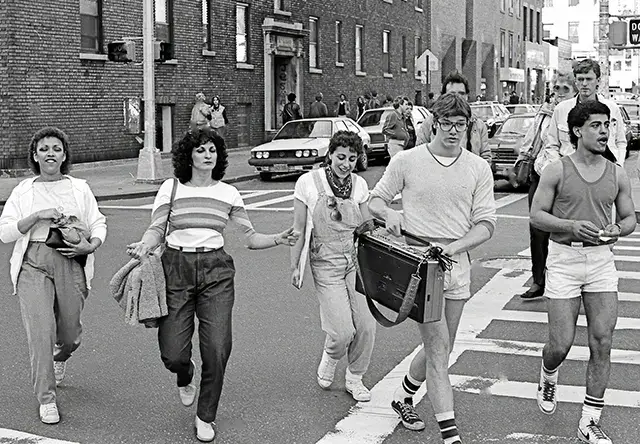 New York City in the 1970s and 1980s was marked by serious challenges to everyday life—graffiti-covered subways, rampant vandalism, piles of uncollected garbage, and high crime rates.
New York City in the 1970s and 1980s was marked by serious challenges to everyday life—graffiti-covered subways, rampant vandalism, piles of uncollected garbage, and high crime rates.
Noise, drugs, and other social issues added to the city’s struggles, making the streets chaotic and unpredictable.
Sidewalks were often littered with dog waste, waiting to catch both unsuspecting visitors and seasoned New Yorkers who happened to lose focus for a moment. It was a rough, gritty time, far from the image of a thriving metropolis.
One of the more disruptive features of life during this period was the boombox. These portable stereos were often played at full volume, contributing to the overwhelming noise of the city.
Whether on busy streets or in places that should have offered some peace, like parks, the boombox seemed unavoidable.
Adding to the frustration, the music was largely limited to disco or hip-hop, leaving little room for other genres. It became an inescapable part of the urban soundscape.
 Boomboxes were known for their weight and size, making them cumbersome to carry for long periods.
Boomboxes were known for their weight and size, making them cumbersome to carry for long periods.
The name itself stemmed from their boxy design and powerful, bass-boosting speakers that produced a distinct “boom.”
Although intended for portability, the increasing demand for louder sound and deeper bass resulted in larger, heavier models by the 1980s—some even as big as a suitcase.
A few of the larger boomboxes even featured vertically mounted record turntables.
 Most boomboxes ran on batteries, with some models requiring as many as 20 D-cell batteries, which only lasted a day of continuous use.
Most boomboxes ran on batteries, with some models requiring as many as 20 D-cell batteries, which only lasted a day of continuous use.
For frequent users, the cost of batteries became a significant expense.
The boombox quickly became a symbol of urban culture in the United States, particularly among African American and Latino youth, earning the nickname “ghetto blaster” due to its widespread presence in these communities.
 Boomboxes came in a wide range of sizes and power requirements.
Boomboxes came in a wide range of sizes and power requirements.
The larger, more powerful models often needed 10 or more D-cell batteries, could span over 76 centimeters (30 inches) in width, and weighed upwards of 12 kilograms (26 pounds).
Some units even utilized a 12-volt sealed lead-acid battery, or served as portable enclosures for car audio systems.
 The introduction of audio jacks helped propel the boombox to peak popularity, driving innovation in both design and functionality.
The introduction of audio jacks helped propel the boombox to peak popularity, driving innovation in both design and functionality.
High-end models were equipped with features and sound quality that rivaled some home stereo systems.
Most boomboxes included basic controls such as volume, tone, and left/right balance, though the quality of these features varied widely across different models.
 In Spike Lee’s 1989 film Do the Right Thing, the character Radio Raheem embodies the cultural associations of the boombox, or “ghetto blaster,” serving as a strong representation of its prominence among urban youth in American media.
In Spike Lee’s 1989 film Do the Right Thing, the character Radio Raheem embodies the cultural associations of the boombox, or “ghetto blaster,” serving as a strong representation of its prominence among urban youth in American media.
Over time, as these devices became more ubiquitous, cities began to ban them from public spaces, and their presence on the streets gradually diminished.
 The boombox became deeply intertwined with hip hop culture, with figures like Fab Five Freddy crediting it as “instrumental” in the genre’s rise.
The boombox became deeply intertwined with hip hop culture, with figures like Fab Five Freddy crediting it as “instrumental” in the genre’s rise.
Certain models, such as the JVC RC-M90 and Sharp GF-777, gained a reputation as “boombox kings” for their ability to overpower others in music battles.
These models were a common sight at street gatherings and in battles where volume and sound quality were crucial.
Iconic groups like the Beastie Boys embraced the boombox as part of their identity, while bands like The Clash always had one in tow.
 The 1990s marked a turning point for the boombox as its dominance in popular culture began to wane.
The 1990s marked a turning point for the boombox as its dominance in popular culture began to wane.
The introduction of more compact devices like the Walkman made large, heavy boomboxes less practical, and they gradually disappeared from city streets.
As boombox enthusiast Lyle Owerko puts it, “Towards the end of any culture, you have the second or third generation that steps into the culture, which is so far from the origination, it’s the impression of what’s real, but it’s not the full definition of what’s real. It’s just cheesy.”
 The decline in demand was reflected in industry numbers.
The decline in demand was reflected in industry numbers.
According to the Consumer Electronics Association, only 329,000 boombox units without CD players were sold in the United States in 2003, a stark contrast to the 20.4 million sold at their peak in 1986.

















(Photo credit: Flickr / Wikimedia Commons / RHP / Library of Congress).

